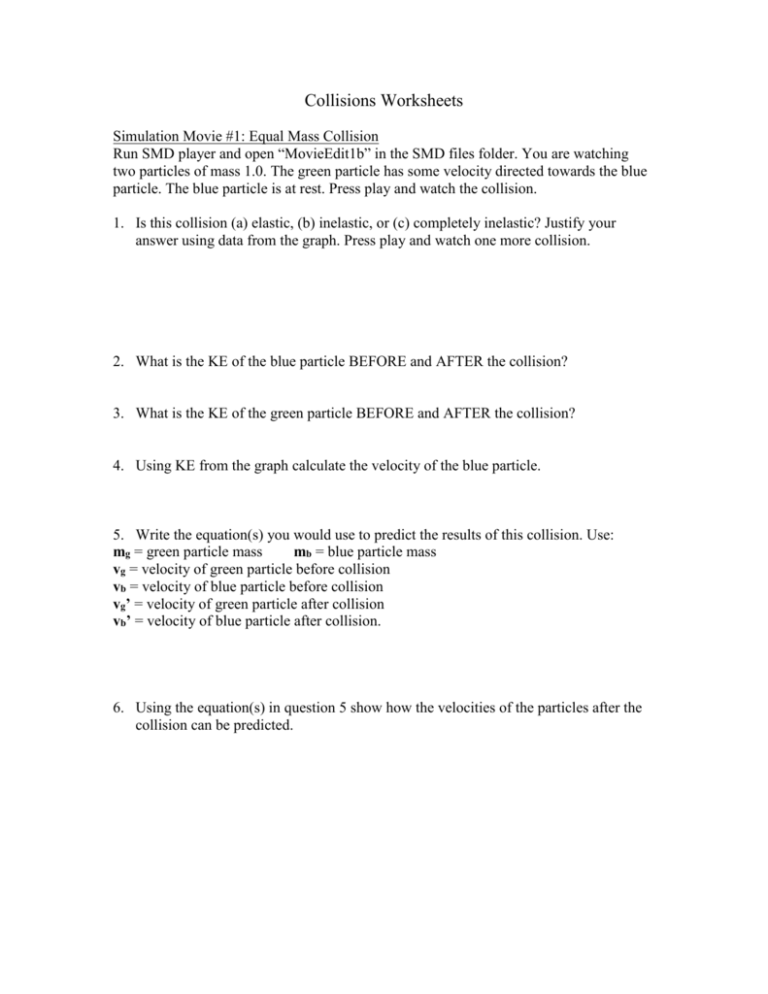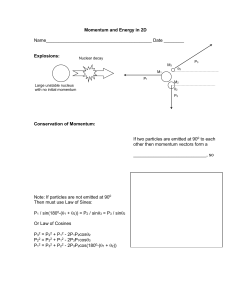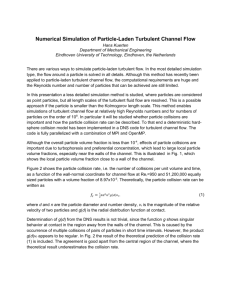Momentum worksheet1
advertisement

Collisions Worksheets Simulation Movie #1: Equal Mass Collision Run SMD player and open “MovieEdit1b” in the SMD files folder. You are watching two particles of mass 1.0. The green particle has some velocity directed towards the blue particle. The blue particle is at rest. Press play and watch the collision. 1. Is this collision (a) elastic, (b) inelastic, or (c) completely inelastic? Justify your answer using data from the graph. Press play and watch one more collision. 2. What is the KE of the blue particle BEFORE and AFTER the collision? 3. What is the KE of the green particle BEFORE and AFTER the collision? 4. Using KE from the graph calculate the velocity of the blue particle. 5. Write the equation(s) you would use to predict the results of this collision. Use: mg = green particle mass mb = blue particle mass vg = velocity of green particle before collision vb = velocity of blue particle before collision vg’ = velocity of green particle after collision vb’ = velocity of blue particle after collision. 6. Using the equation(s) in question 5 show how the velocities of the particles after the collision can be predicted. Simulation Movie #2: Double Mass Collision Run SMD player and open “MovieEdit2c” in the SMD files folder. You are watching two particles. The green particle has mass = 1.0. The blue particle has mass = 2.0. The green particle has a velocity directed towards the blue particle, which is at rest. Press play and watch the collision. 1. What is the KE of the green particle BEFORE and AFTER the collision? 2. What is the KE of the blue particle BEFORE and AFTER the collision? 3. What is the total mechanical energy of the system? 4. Is this collision (a) elastic, (b) inelastic, or (c) completely inelastic? Justify your answer using data from the graph. 5. Write the equation(s) you would use to predict the results of this collision. Use: mg = green particle mass mb = blue particle mass vg = velocity of green particle before collision vb = velocity of blue particle before collision vg’ = velocity of green particle after collision vb’ = velocity of blue particle after collision. As indicated in the movie, in the space below, use the proper equations and data from graphs to predict the velocity of each particle after this collision. Simulation Lab Practice Run SMD and open “Collisions1a” in the SMD files folder. The mass of each particle is set at 1.0, and the green particle will begin with a velocity directed towards the blue particle along the horizontal axis. Press play. Notice the velocity and kinetic energy of each particle before and after each collision. Watch the simulation and graphs carefully. Press pause and play as you wish. You should become familiar with the following before moving on: (1) The collisions you are watching are ELASTIC, so kinetic energy is conserved in the collision. (2) The Law of Conservation of Momentum and kinetic energy conservation can be used to predict the velocities of the particles after each collision. (3) When particles of equal mass collide elastically in which one particle begins at rest, then all of the kinetic energy transfers from one particle to the other. Questions: 1. Two particles of equal mass undergo an elastic collision. Particle #1 has a speed of 10 m/s due east, and particle #2 is at rest. After the collision, what are the velocities of each particle? 2. Two particles of equal mass undergo a collision and stick together. Particle #1 has a speed of 10 m/s due east, and particle #2 is at rest. After the collision, what is the velocity of the two particles? 3. Consider the following questions for discussion: a. What are examples of elastic collisions? b. Do elastic collisions actually exist? c. Are there situations in which collisions are nearly elastic? d. Where does the energy go if a collision is not elastic (inelastic)? e. What equation(s) can be used to make predictions of inelastic collisions? Now reset the experiment under the File menu. Adjust the mass of the blue particle to 2.0. Then press play. Notice the velocity and kinetic energy of each particle before and after each collision. Watch the simulation and graphs carefully. Press pause, play and reset the experiment as you wish. You should become familiar with the following before moving on: (1) The collisions you are watching are still ELASTIC, so kinetic energy is conserved in each collision. (2) The Law of Conservation of Momentum, and kinetic energy conservation can be used to predict the velocities of the particles after each collision. Questions: 1. Two particles are about to collide elastically. Particle #1 has a mass of 5.0 kg, and is moving along the horizontal axis with a velocity of 10 m/s. Particle #2 has a mass of 10 kg and is as rest. Determine the velocity of each particle after the collision. 2. Two particles are about to collide. Particle #1 has a mass of 5.0 kg, and is moving along the horizontal axis with a velocity of 10 m/s. Particle #2 has a mass of 10 kg and is as rest. After the particles collide they stick together. Determine the velocity of each particle after the collision. 3. Consider the following for discussion: a. Can you answer the question #1 if the collision was not elastic and not completely inelastic? b. What is the total mechanical energy of the system in the question above? c. If you dropped a ball and let it collide with the ground, how high would the ball rebound if the collision with Earth were (a) elastic, (b) inelastic, and (c) completely inelastic? In which of these collisions is momentum conserved? In which of these collisions is kinetic energy conserved? Now reset the experiment under the File menu. Adjust the mass of the blue particle to ____. Then press play. Notice the velocity and kinetic energy of each particle before and after each collision. Watch the simulation and graphs carefully. Press pause, play and reset the experiment as you wish. You should be able to predict the velocities of the particles after each collision. YOUR ASSIGNMENT: Create a PowerPoint presentation and a movie using SMD player to show other high school students how to predict velocities of particles the undergo elastic collisions. In your movie, the initial velocity of the green particle is 3.0 (computer units) directed towards the blue particle along the horizontal axis. The blue particle will start at rest. The mass of your blue particle must be _____, which is what you played with in the simulation above. Your PowerPoint presentation should include 1. A comparison of elastic, inelastic, and completely inelastic collisions and examples of each. 2. Compare and contrast momentum and kinetic energy. 3. The definition of the Law of Conservation of Momentum and Law of Conservation of Energy. 4. An explanation of which equations can be used to predict the velocities of particles after elastic, inelastic and completely inelastic collisions. 5. An example elastic collision problem between two particles which you solve using the principles you learned. Additional requirements: 1. Your PowerPoint presentation should not be longer than 18 slides. 2. You must turn in both your SMD movie and PowerPoint together on a floppy disk. The due date for this project is ___________








